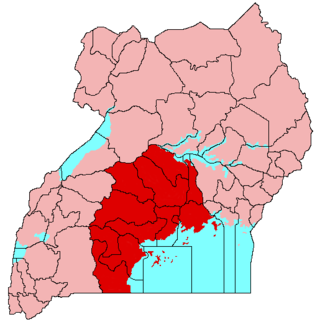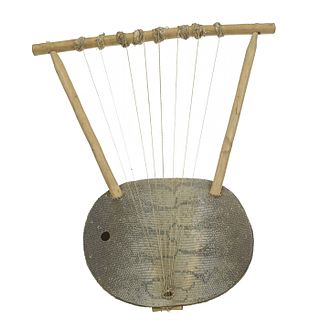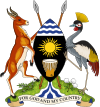Related Research Articles

Buganda is a Bantu kingdom within Uganda. The kingdom of the Baganda people, Buganda is the largest of the traditional kingdoms in present-day East Africa, consisting of Uganda's Central Region, including the Ugandan capital Kampala. The 14 million Baganda make up the largest Ugandan region, representing approximately 16% of Uganda's population.
The early history of Uganda comprises the history of Uganda before the territory that is today Uganda was made into a British protectorate at the end of the 19th century. Prior to this, the region was divided between several closely related kingdoms.
Soga, or Lusoga, is a Bantu language spoken by the Soga people of the Busoga region in Eastern Uganda. With over three million speakers, it is one of the major languages of Uganda, after English, Swahili, and Luganda. However, it is largely restricted to the Busoga region, which is mainly within the natural boundaries of Lake Victoria to the south, Lake Kyoga to the north, the Nile river to the west and the Mpologoma ('Lion') river to the east of Namutumba district. It is tonal.

Uganda, is now ranked number three in Africa as far as music and entertainment is concerned. Uganda is home to over 65 different ethnic groups and tribes, and they form the basis of all indigenous music. The Baganda, being the most musically vibrant nationality in the country, has defined what constitutes culture and music of Uganda over the last two centuries.

Bunyoro, also called Bunyoro-Kitara, is a Bantu kingdom in Western Uganda. It was one of the most powerful kingdoms in Central and East Africa from the 13th century to the 19th century. It is ruled by the King (Omukama) of Bunyoro-Kitara. The current ruler is Solomon Iguru I, the 27th Omukama.

Kamuli District is a district in the Eastern Region of Uganda. The town of Kamuli is the site of the district headquarters.

Busoga is a kingdom and one of four constitutional monarchies in present-day Uganda. The kingdom is a cultural institution which promotes popular participation and unity among the people of the region through development programs to improve their standard of living.

Baganda music is a music culture developed by the people of Uganda with many features that distinguish African music from other world music traditions. Parts of this musical tradition have been extensively researched and well-documented, with textbooks documenting this research. Therefore, the culture is a useful illustration of general African music.
Kintu is a mythological figure who appears in a creation myth of the people of Buganda, Uganda. According to this legend, Kintu was the first person on earth.
Jjunju Sendegeya was Kabaka of the Kingdom of Buganda from 1780 until 1797. He was the twenty-sixth (26th) Kabaka of Buganda.

The endongo is a musical instrument, considered the national instrument of the Baganda people of Uganda. It is a member of a family of lyres which can be found, with variations, in many areas throughout East Africa. The endongo is specifically a Kiganda bowl lyre, with the face of the bowl covered with the skin of either a monitor lizard or ant lizard.

The history of Buganda is that of the Buganda kingdom of the Baganda people, the largest of the traditional kingdoms in present-day Uganda.

The endingidi is a type of bowed string instrument native to Uganda. The endingidi has one string, extending from the neck to a cylindrical sound-box or resonator made of wood or cow horn. A piece of hide is stretched over the top of the cylinder and is fixed to the sound-box with wooden pegs, thorny spines or nowadays also with metal nails. The hide used is usually that of the monitor lizard but also of young goats and sheep or even of the python. The hide is soaked in water for a whole day before being stretched over the sound-box. The neck consists of a straight wooden stick inserted through the walls of the sound-box at about 2 to 3 cm from the top. At the top of the neck a hole is bored at 4 to 6 cm from the end into which a tuning pin is inserted vertically. The string is secured to this pin in such a way that the string can be wound round the pin in a similar way as with a violin. This allows the string to be tightened, so tuning the instrument. The string runs across the sound-box via a bridge and is fixed to the other end of the neck. The string is made of fibre or animal sinew, but nowadays it is more often of nylon. The arched bow consists of a thin flexible twig, to which a string is attached, usually of the same material as the string of the instrument itself. To give the bow more grip on the string of the instrument, resin is rubbed into the bow string. The resin is often attached to the side of the sound-box so the player can easily rub resin on the bow as he plays.

The Baganda also called Waganda, are a Bantu ethnic group native to Buganda, a subnational kingdom within Uganda. Traditionally composed of 52 clans, the Baganda are the largest people of the Bantu ethnic group in Uganda, comprising 16.5 percent of the population at the time of the 2014 census.
Buruuli (place) is a general term used to refer to the area where the Baruuli live. It is located in the district of Nakasongola, as well as in Bugerere Kayunga District. The Baruuli speak the Ruruuli language, a Bantu language closely related to Lunyala, a language spoken by the Banyala of Kayunga District. The Baruuli are ruled and governed by Ssabaluuli Mwogezi, who was crowned as their Kabaka by the president of Uganda Yoweri Kaguta Museveni.
Mugoyo is a traditional main course dish in Uganda. It is served in most regions in Uganda and is defined as mingled. The main ingredients of the dish are sweet potatoes and beans.

Engalabi aka Engoma ensajja is an Membranophone percussion instrument that is used in Central Africa especially in Uganda by tribes which include the Baganda, Banyankole, Buzimba, and Tagwenda. It is also known as omugalabi, engaija, egaabi, omugudu, omugwabe, long drum, Engaabe, emiidiri.
Bakisimba dance (Baakisiimba) also known as Nankasa or Muwogola is a traditional dance form originating from the Baganda people of Buganda Kingdom in Central Uganda. It is believed to have originated from the movements of a drunken King Ssuuna of Buganda Kingdom. The dance was initially performed in the Buganda Royal Court in ancient times an it holds significant cultural and social importance within the community and is often performed during tribal ceremonies, celebrations, and festive occasions.
Tamena Ibuga also known as the harvest celebration dance of the Basoga people, is a traditional dance originating from the kingdom of Busoga in eastern Uganda. This dance holds great significance as it represents the spirit of friendship and unity among the Basoga community. Typically performed during the harvest festival, Tamena Ibuga serves as a reminder and encouragement to the Basoga people to continue their diligent harvesting efforts. Through this exceptional dance, the Basoga people celebrate and honor the fruitful cultivation of their lands, acknowledging the bountiful harvest they have achieved.
Amaggunju is a traditional folk dance of the Baganda, who represent the largest ethnic community in Uganda. This royal dance is performed during important occasions such as coronations, weddings, and other cultural events. Notable features of the dance are its distinct rhythmic drumming and energetic movements, executed by both male and female performers.
References
- 1 2 3 4 "Bigwala", UNESCO.org.
- ↑ "Bigwala | Singing Wells" . Retrieved 2024-01-19.
- ↑ Pier , David G. (2015). "Marketing Ebigwala to UNESCO: Strategies and Outcomes", Ugandan Music in the Marketing Era: The Branded Arena. Springer. ISBN 9781137546975.
- ↑ Pier (2015).
- ↑ Jidovanu, Natalia (2019-03-29). "To Revive This Royal Music, Ugandans Had to Grow New Instruments". Atlas Obscura. Retrieved 2024-01-19.

